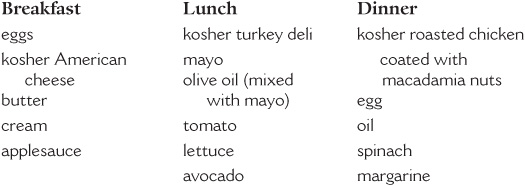
MY CHILD IS ON A GLUTEN-FREE DIET. CAN THE KETOGENIC DIET BE DONE? WHAT ABOUT IF WE ARE VEGETARIAN?
The ketogenic diet can be used for all different cultures and food restrictions. It is used in all continents except Antarctica. In China, Japan, and Korea, it is growing incredibly in popularity. Similarly, in India, it is also becoming widely used.
Many parents would think that it would be impossible to try a diet that already limits many of their child’s favorite foods; however the ketogenic diet can be used for any child that has gastrointestinal restrictions, allergies, preferences, or follows any diet for religious reasons. Prior to diet initiation, it is important for the parents to inform the doctor or dietitian seeing the patient of all the child’s allergies or religious food restrictions.
Keeping kosher is a set of biblical dietary restrictions that many observant Jewish people follow. The word kosher is Hebrew and means fit, proper, or correct. The diet consists of restricting certain foods like pork and shellfish, and not mixing certain foods together like milk and meat. Due to these restrictions many foods have certifications from Rabbis to identify that the food is kosher.
When people see pictures of the ketogenic diet, they think of a lot of butter, cream, and hot dogs. When eating kosher, because hot dogs are meat they cannot be eaten with butter or cream, which are both dairy. However, there are many substitutions for either the dairy products or the meat products.
Noah is a 5-year-old male with Doose syndrome. Prior to starting the diet he was on a regular kosher diet. He ate three meals and two snacks averaging 1,200 calories per day. He has always had normal growth. His parents were very concerned about starting the ketogenic diet while maintaining their religious beliefs and keeping a kosher diet. A closer look at Noah’s diet showed he liked all proteins, including eggs, cheese, chicken, ground beef, and turkey; he liked a lot of carbohydrates, but he was not much of a milk drinker. By reviewing with the parents what foods cannot be mixed together and finding foods that are pareve, those that can be combined with the meat or dairy meals, the dietitian was able to come with a meal plan.
Noah did very well on the ketogenic diet and was seizure-free within the first 2 weeks of starting the diet. With the help of ketogenic diet computer programs, Noah’s parents were able to use their kosher brands of foods and make it work on the ketogenic diet.
SAMPLE KOSHER MEAL PLAN

Snacks
peanut butter and margarine
“keto yogurt” (sour cream, heavy cream, and fruit)
Currently the only kosher formula on the market is the modular version with RCF®, Microlipid®, and Polycose®. KetoVolve®, although not on the U.S. market at time of publication, claims it will be kosher certified.
Halal is an Arabic word meaning permitted or lawful. Halal is a term that applies to all facets of Muslim life, including food. All foods are considered Halal except for pork, alcohol, carnivorous animals, animals that were improperly slaughtered, and any food product containing any of the mentioned products. Starting the ketogenic diet while keeping the laws of Halal is not difficult; all you need to do is obtain the food values for each product, and each product can be added to the computer program to calculate the meals. A meal plan for a child who only eats Halal would be very similar to the kosher meal, however, someone who eats only Halal can mix milk and meat together and have cream or butter mixed into their foods.
There are many children with food allergies or intolerances. Your child could be allergic to only milk or have multiple food allergies consisting of milk, soy, eggs, wheat, and nuts. You might wonder how your child could go on a restrictive diet when you already have to restrict his or her diet.
Jake was allergic to milk, soy, eggs, nuts, and chicken when his mother was considering the ketogenic diet. After being informed about the diet, she looked up online what the diet entails and saw on every site recipes that consist of eggs, cream, and butter. Jake’s mother called the doctor to say that she was unsure if Jake could go on the diet with his multiple food allergies. When we spoke to Jake’s mom, she sat down with us and reviewed Jake’s current intake. He was eating baby food beef mixed with baby food vegetables or fruit, coconut milk, and coconut butter. We informed Jake’s mother that going on the ketogenic diet was not going to change his diet that much. He could still eat his baby food meats, fruit, and vegetables, and now they would be mixed with coconut oils or milk.
The trick with allergies is to look at what the child is currently eating, and pair it with a fat that they can tolerate. There are so many options out there now for patients that have allergies that it is not difficult at all.
Milk Allergies
Ingredients to avoid:
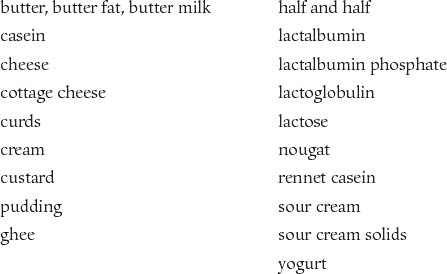
For high fat keto replacements:
1. instead of butter, try margarine;
2. instead of cream, try coconut milk; and
3. remember, mayonnaise and oils are both dairy free.
Egg Allergies
Read the labels and avoid:
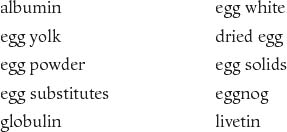
To replace an egg needed for baking, one of the following may be substituted in recipes; however, each ingredient needs to be calculated for each recipe, and they still do not provide enough protein.
• 1 tsp baking powder, 1 tbsp water, 1 tbsp vinegar
• 1 tsp yeast dissolved in 1/4 cup warm water
• 1 tbsp apricot puree
• 1 1/2 tbsp water, 1 1/2 tbsp oil, 1 tsp baking powder
• 1 packet gelatin, 2 tbsp warm water (do not mix until ready to use)
Soy Allergy
Ingredients to avoid:
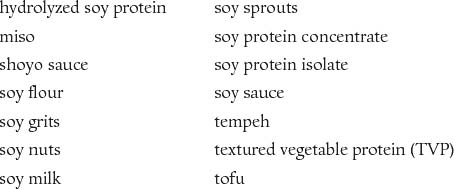
And watch these products because they may contain soy:

Peanuts and Tree Nut Allergies
Peanuts and tree nuts are high in fat and a good source of protein, which is why they are found in a lot of ketogenic recipes; however, they are not an essential part of the ketogenic diet and can be eliminated.
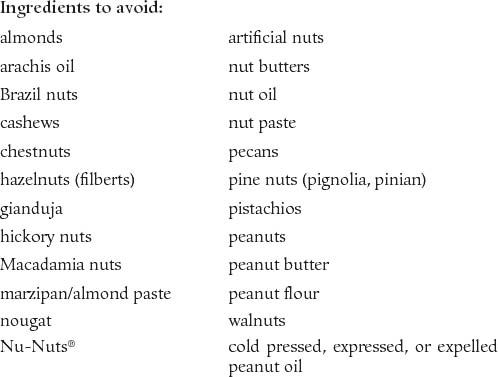
Wheat Allergies
A wheat allergy is actually very easy on the ketogenic diet because most products containing wheat are very high in carbohydrates. However, there are some food products that have wheat in them that you would not expect.
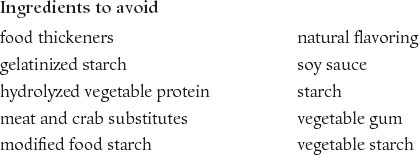
Children with any allergy or multiple allergies should have no issue going on the ketogenic diet. However, there must be a long conversation among the doctor, dietitian, and family about the allergies and food intolerances.
Sample Meal Plan for Multiple Food Allergies
Breakfast: coconut pancake (coconut flour, coconut oil, flaxseed, coconut milk, baking powder, gelatin)
Lunch: chicken, avocado, canola oil, coconut milk, and spinach
Dinner: salmon, butternut squash, canola oil, and coconut milk
Snack: bacon, canola oil, McDonalds french fries, coconut milk, and fruit
For children that have multiple food allergies and require a formula, a modular formula needs to be used. If the child is allergic to only milk, then RCF®, Polycose®, and Microlipid® can be used. If the child has multiple food allergies, then Complete Amino Acid® mix is used instead of RCF®. Complete Amino Acid® mix is just the essential proteins and does not contain any vitamins and minerals.
There are many children who follow a gluten-free, casein-free diet for autism or behavioral issues. Gluten is a protein found in wheat, rye, and barley and is the material in flours that acts like a glue and holds the dough together. Maintaining a gluten-free diet on the ketogenic diet is not difficult because gluten is found in foods that are high in carbohydrates. Casein is also a protein found in milk products. Therefore, all cheeses, yogurts, and any product containing milk are avoided.
Children on a gluten-free, casein-free diet before starting the ketogenic diet will follow a diet similar for those with a milk allergy. All dairy is removed and replaced with nondairy items, such as margarine and oils.
There are many different types of vegetarianism, and people choose to follow a vegetarian lifestyle for multiple reasons. The most restricted form of vegetarianism is a vegan diet, which omits all animal products from a diet. While following a vegan diet, the most concerning nutritional issue is protein intake; nevertheless, there are multiple ways to take in adequate protein by eating beans or eating meat or fish substitutes while on a regular vegan diet.
The issue with following a vegan diet while on the ketogenic diet is that beans and meat substitutes are usually high in carbohydrates as opposed to an animal protein like chicken, which has zero carbohydrates. However, there are protein powders available that could be added to meal plans of cream, fruit or vegetable, and oils and margarine.
If a family chooses to follow any other form of vegetarianism, such as lacto ovo or pescetarian, usually omit only 1–2 types of animal protein and eat all of the others.
Many families choose to buy only organic foods, both produce and prepared foods. This is a choice made by the family. There are no studies indicating increased seizure reduction while eating an organic diet, however, many people believe that the food is better for you. There are no contraindications to following a completely organic diet while on the ketogenic diet.
It is important for parents and clinicians to realize that the ketogenic diet can be done with all different types of diets. The most important thing is to look at what the child is eating prior to starting the diet, and figure out a way that fats can be added to what that child currently eats. If the child has an allergy, then look at the foods that he is currently eating and figure out how to add in the fat. Are the parents going to mix oil with mayonnaise? Can they mix coconut oil into the baby foods? If these or similar questions can be answered positively, then that child can start the ketogenic diet and will be very successful. It’s up to the parents to be enthusiastic about the foods, and it’s up to the clinicians to encourage and support the parents and patient while they are evaluating which foods will fit into their lifestyle.